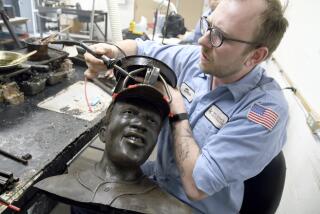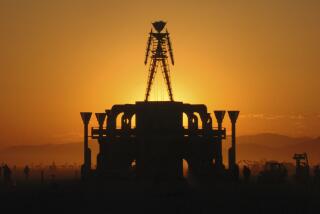Bosnian Group Sees Statue in Bad Light
- Share via
SARAJEVO, Bosnia-Herzegovina — The enemies of “Multiethnic Man” usually come in the night, armed with coarse black cloth to carry out their reading of Allah’s will.
Their target is a bronze nude, cast to leave every doubt as to his race but none about his sex.
Italian sculptor Francesco Perilli conceived the statue as a celebration of tolerance. But a militant Muslim group here sees “Multiethnic Man” as pornography at worst, idolatry at best for celebrating the human form over God, and says the artwork has no place in Sarajevo’s Liberation Square.
El Fetih, a small but determined force of moujahedeen, or holy warriors, left over from the war that ended in Bosnia three years ago, has threatened to blow up “Multiethnic Man” if necessary.
The militants have tried peaceful means, such as sneaking up in darkness and wrapping the statue in black cloth, but each mission has failed. Someone--the police, an art lover, a liberal or one of Sarajevo’s legions of poor in need of good cloth--has always pulled down the covering, and “Multiethnic Man” stands naked again.
Most anywhere else, it might seem ridiculous. But in Bosnia-Herzegovina, where many thousands of people died trying to keep a multiethnic, tolerant democracy alive, the attacks on Perilli’s statue rip open old wounds.
Edin Avdic, arts and culture editor of the periodical Slobodna Bosna, shakes with rage when he talks about the campaign by what he sees as fanatics with few supporters among the Muslim majority here in Bosnia’s capital.
“They have opted for such rigid moves as covering the statue because that is the only way to achieve something, knowing what big losers they are,” said Avdic, a Muslim.
Sarajevo received the statue as a gift from Italy’s Abruzzo region, Perilli’s home, so the sculptor is careful in discussing his work and what the people of Sarajevo have done with it.
“When you get a gift, you can put it in your living room, in your dining room or in the cellar,” he said from Italy. “It’s up to you.”
He doesn’t want to bow to a militant minority. But Perilli said he is willing to talk about making changes if opposition is more widespread.
Far from defeating his message, Perilli said, the enemies of “Multiethnic Man” are strengthening it.
“First of all, it’s a start to see the symbol, to discuss it, to modify it if there is a necessity to do so,” he said. “Every time you talk in a civilized way about it, it can only be improved.”
Perilli, a 49-year-old painter and sculptor who has exhibited works in New York and Paris, is trying to put up copies of “Multiethnic Man” on five continents: Europe, North America, Africa, Asia and Australia.
So far, he has managed to install only two. The first statue went up in Toronto in 1985. Sarajevo came next, on July 14, 1997.
Perilli thinks that South African President Nelson Mandela is close to granting “Multiethnic Man” a place in Cape Town. If that happens, the artist will try to persuade Beijing and Sydney, Australia, to complete his dream.
Sarajevo’s politicians were happy to be seen with “Multiethnic Man” when it was unveiled, Avdic said, but they are silent now that it is under attack.
His magazine made the controversy its cover story in the Sept. 26 issue, with a cartoon lampooning Alija Izetbegovic, the Muslim member of Bosnia’s three-person presidency, for not defending the statue and its message.
The cartoon shows Izetbegovic as the statue, dressed in a loose, sheer black cloth and surrounded by a mob of angry women dressed in Islamic garb. Off to one side is an unmistakable Monica Lewinsky, making eyes at him.
El Fetih is a shadowy organization whose leaders are difficult to locate, but the Sarajevo area’s minister for veterans affairs, Harun Imamovic, is known to be sympathetic with their cause.
He refused, through an aide, to be interviewed about the statue. “The minister said that the subject is a tricky one,” the aide said. “He wouldn’t like to give any comment at all on that subject.”
Imamovic was more frank with Slobodna Bosna, which quoted him as saying he had met with members of El Fetih and personally provided 10 yards of cloth for covering the statue.
Muslims throughout their history have fought statues as a form of idolatry, Imamovic told Slobodna Bosna.
“Unfortunately,” he said, “it seems that the time has come for Muslims to fight against them again.”
More to Read
Sign up for Essential California
The most important California stories and recommendations in your inbox every morning.
You may occasionally receive promotional content from the Los Angeles Times.













